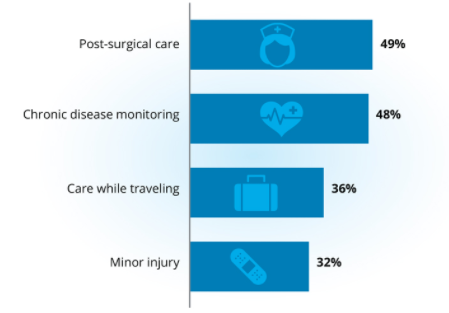 By Lauren Cranford, Marketing Manager, Chiron Health
By Lauren Cranford, Marketing Manager, Chiron Health
Twitter: @chironhealth
Modern patient-care related technologies such as online medical records (EHRs) and health portals, telemedicine, and wearable devices have the potential to put patients in greater control of their health than ever before. They improve access to information, make getting care more convenient and less expensive, and improve health outcomes.
Given all of that, you’d expect that patients would be clamoring for providers to make these technologies available, and many certainly are. But others can be slower to accept the new, increasingly digital healthcare landscape. The benefits of increased use of patient-care related technologies for practices are substantial, making slow patient adoption a frustrating problem for some providers. If you are facing this challenge in your practice, here are a few steps you can take to help more of your patients embrace these valuable tools.
1. Choose Technologies that Solve Problems for Patients
In these days when there is an app for everything, it can be easy for people to become overwhelmed. It doesn’t make sense to offer technology just because you can. Instead, focus on technologies that solve problems for patients. Ask patients what keeps them from active management of their own care and what barriers they face, then look for solutions for these important patient concerns.
2. Prioritize Ease of Use
Before you introduce any technology in your practice, consider how easy it will be for the majority of your patients to use. The best applications have an intuitive user interface that is similar to other applications that patients already love. They should not be full of jargon or require specific technical knowledge to operate. Applications should work seamlessly on the devices that patients already have, and wearable technology should be unobtrusive and comfortable. The Smart Wearables in Healthcare 2016-2030 report predicted that the overall market for smart wearables within healthcare will grow at an annualized rate of 13.6% over the next 15 years.
3. Use a Multi-Channel Approach to Education
Of course, the first step to getting people to use a particular technology is to make them aware that you offer it and help them understand what it is. This can be accomplished using a variety of communication tactics. Information can be distributed in-person when the patient visits the office and reinforced with signage. Email messages and website content are also good ways to share program details. People react to this type of marketing in different ways, so it makes sense to diversify.
4. Explain the Benefits
Patients may not always be able to make the logical leap from what the technology does to how it will be good for them. It is important to provide specific examples of how the new tool might improve their health, reduce costs or save them time. For example, instead of saying that video visits can replace in-person visits, one might say that video visits can replace missed time from work, frustrating trafficand time spent in the waiting room. Providing patients with examples of appropriate telemedicine visits could drive appointment volume as well. A recent study concluded the following:
Telemedicine Care that Patients Are Most Interested In
 Source: Deloitte 2016 Survey of US Health Care Consumers, Deloitte University Press
Source: Deloitte 2016 Survey of US Health Care Consumers, Deloitte University Press
5. Work Up to It Slowly
Some patients will be excited to manage their health information online and conduct follow-up appointments remotely; others won’t. But they may be open to getting appointment reminders via text or preventative care recommendations via email. The “toe in the water” approach can work wonders when it comes to technology adoption.
6. Integrate Technology into Normal Processes and Conversations
If tests are ordered, for example, make sure you let the patient know that the results will be available in the patient portal. Remind patients that their next appointment can be scheduled online. Train staff to suggest a video-visit when someone calls to make an appointment.
7. Address Concerns and Risks
Whether in person or in your marketing communications, be sure to acknowledge that patients do have some level of apprehension when it comes to the intersection of technology and healthcare. Will it be too difficult to use? Will it prevent me from getting the best quality care? Will the digital experience be impersonal? Will I still be able to see my doctor in real life if I want to? Will my insurance cover this type of care? It makes sense to get these fears on the table and work through them together.
8. Be Consistent
Marketers know that, on average, people need to be exposed to a message nine times before they act. This means that one email blast about your new telemedicine program or the availability of online health management isn’t likely to get you to the utilization levels you would like to see. It makes sense to develop a regular cadence of communication so that your message might reach someone at just the right time.
9. Make it Personal
It is one thing to say that video visits, for example, are convenient for patients. It is quite another to say, “Bob, we can do a better job of managing your medications and free up some of your time by doing your med checks via video.” Each patient has unique needs and a different tolerance for change, so it pays to explain each person’s options in the context of their specific healthcare needs.
10. Engage Caregivers
By 2020, it’s expected that 45 million Americans will be serving as caregivers (Deloitte University Press), and more than 20% of the U.S. population is expected to be over the age of 65 by the year 2030, according to the U.S. Census Bureau. Patient-care related technologies offer significant advantages for caregivers as well as patients. Caregivers can be a powerful ally in your effort to get a reluctant patient to try something new. They can also prove to be a source of support and feedback.
11. Attract Enthusiastic Patients
Helping your existing customers accept patient-care related technology is important, but you can also make efforts to attract new patients who will welcome these modern options. Be sure to include the technology programs you offer on your practice website and other marketing material. Promote the fact that your practice is progressive in its efforts to leverage new avenues to excellent, cost effective and convenient care.
For more guidance on your website, see 5 Simple Steps to Creating a Website Your Patients Will Love.
Medicine has never been a one-size-fits-all affair and it never will. Some patients simply won’t engage with the technology solutions you offer. That’s ok. But with education, small positive experiences and your guidance, many will come around and soon wonder how they ever lived without these indispensable tools.
This article was originally published on Kareo’s Go Practice Blog and is republished here with permission.
